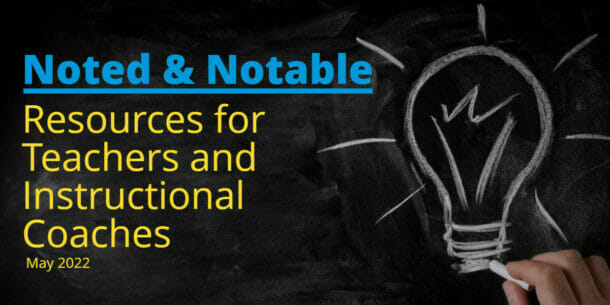Resources for Teachers and Instructional Coaches – May 2022

Teacher collaboration and teacher stress—these can cause a lot of frustration.
This edition of noted and notable content for educators includes popular education articles about both topics.
Here are our top picks for the May 2022 reads you shouldn’t miss. Read on for the highlights, article links, and related content.
Keep teacher stress in check
Saying teachers are stressed is no understatement. And with the end of the school year, things can feel like a whirlwind.
But, this Edutopia post states, “While a lot remains out of our control, there are things we can do to help ourselves mitigate some of our stressors.”
Here are 3 ways to reduce teachers’ stress:
- Build your teacher team. By cultivating relationships with the teachers in my school, my teacher team, I have effectively created a support group for myself that understands what I am facing each day in the classroom. I am able to rely on this team whether I am struggling with a specific student or just need someone to talk to throughout the day.
- Prepare for planning. At the beginning of the week, I schedule out the things that must get done each day during my planning. I am practical with how long things will take and only list the absolute necessities. I have a second list where I put the things that I would like to get done but could live without accomplishing. By explicitly organizing what I will focus on in advance, I am able to get started on tasks right away.
- Create space. In my experience, this has meant leaving my work at work. While it isn’t always possible, especially as deadlines creep up, I do my best to complete everything that needs to get done for school while I am at school. Once I leave, I know that I am only responsible for focusing on myself and my family.
Read the full post at Edutopia for more about the ways to reduce teacher stress: 3 Ways Teachers Can Reduce Their Stress Level
Teachers, thinking of how to stay positive? Learn the 5 steps to creating a mental health wellness plan.
Foster the process of learning together as educators
Educator collaboration is key to teachers improving their practice and stronger student outcomes.
This ASCD article outlines a new way to approach professional learning communities with a four-step protocol called Achievement Teams for stronger teacher collaboration. Here are the 4 steps:
- Collect and chart the data.Achievement Teams focus on evidence from quality short-cycle assessments.
- Set SMART goals. Goals motivate both students and teachers to exert extra effort in line with a specific task. They also have a self-energizing effect, especially if they are set at an appropriate level of rigor.
- Create baseline evidence statements. Summarizing collected data helps educators make inferences around students’ mastery levels. These statements assist teachers to reflect on their practice, especially as they review assessment results.
- Select high-yield instructional strategies. Teachers select the strategies that will have the greatest impact on student achievement and they should have access to contemporary research highlighting these strategies. This process provides a structure for teachers to accurately reflect on their practice between pre- and post-assessments and then work together to decide on the best corrective instructional approach in response to those identified needs.
Read more about each of the steps for more effective teacher collaboration at ASCD: 4 Steps for Creating Stronger, More Collaborative Teacher Teams
Using SMART goals but want to try out a different goal-setting framework? Check out our guide to Jim Knight’s PEERS goals.
Missed last month’s edition of resources for teachers and coaches? Catch up on our Apr. 2022 top resources for teachers and coaches!
